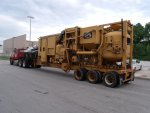Like I'm the first guy to use the "in free air" rating of conductors on a construction site.
BTW, that is straight out of either a Delco or EMD manual from the 1950's
I can't inmagine what it's like to have an unlimited budget to set up a construction site that will only be in operation for a few months before everything is taken down and moved.
My customer has some portable dust collectors with 100HP 3 phase 1800 rpm motors. And at times they may be thousands of feet from the generator/generators. They need all the help they can get.
Just for size reference, here is one of the diesel powered units I was moving one day
I'm so DIY that I bought a 20,000 pound Hyster H200 forklift and a 6,000 pound Lull telehandler last year just to set the machinery up on jobsites.


